2007 CHEVROLET EXPRESS PASSANGER check engine
[x] Cancel search: check enginePage 293 of 458
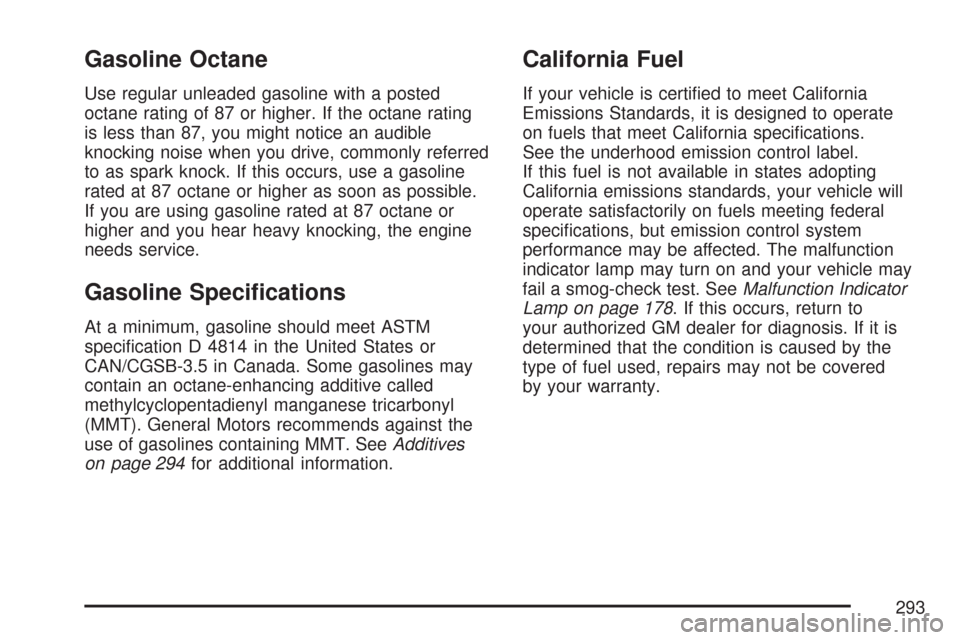
Gasoline Octane
Use regular unleaded gasoline with a posted
octane rating of 87 or higher. If the octane rating
is less than 87, you might notice an audible
knocking noise when you drive, commonly referred
to as spark knock. If this occurs, use a gasoline
rated at 87 octane or higher as soon as possible.
If you are using gasoline rated at 87 octane or
higher and you hear heavy knocking, the engine
needs service.
Gasoline Speci�cations
At a minimum, gasoline should meet ASTM
specification D 4814 in the United States or
CAN/CGSB-3.5 in Canada. Some gasolines may
contain an octane-enhancing additive called
methylcyclopentadienyl manganese tricarbonyl
(MMT). General Motors recommends against the
use of gasolines containing MMT. SeeAdditives
on page 294for additional information.
California Fuel
If your vehicle is certified to meet California
Emissions Standards, it is designed to operate
on fuels that meet California specifications.
See the underhood emission control label.
If this fuel is not available in states adopting
California emissions standards, your vehicle will
operate satisfactorily on fuels meeting federal
specifications, but emission control system
performance may be affected. The malfunction
indicator lamp may turn on and your vehicle may
fail a smog-check test. SeeMalfunction Indicator
Lamp on page 178. If this occurs, return to
your authorized GM dealer for diagnosis. If it is
determined that the condition is caused by the
type of fuel used, repairs may not be covered
by your warranty.
293
Page 295 of 458
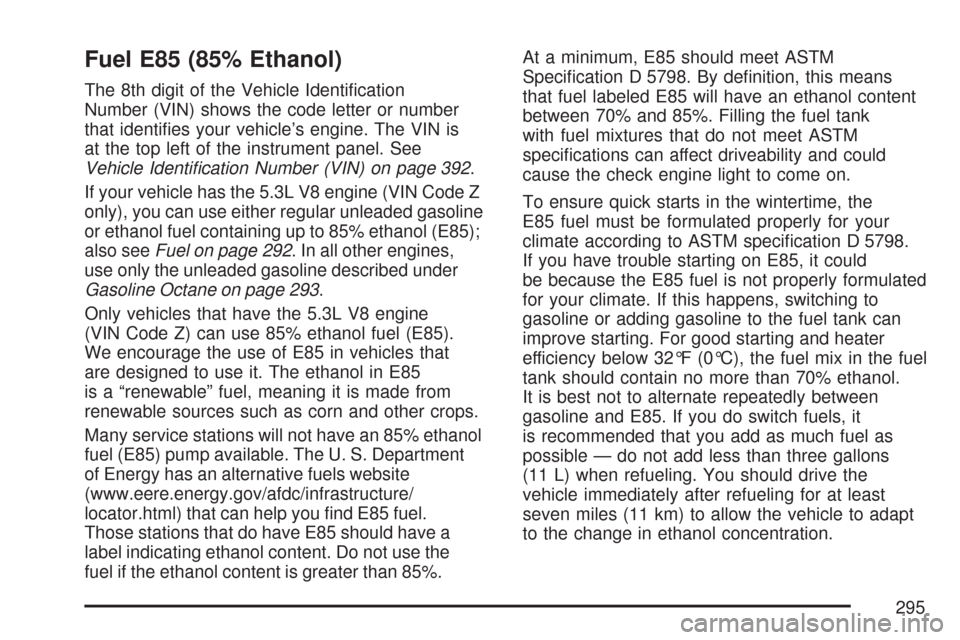
Fuel E85 (85% Ethanol)
The 8th digit of the Vehicle Identification
Number (VIN) shows the code letter or number
that identifies your vehicle’s engine. The VIN is
at the top left of the instrument panel. See
Vehicle Identi�cation Number (VIN) on page 392.
If your vehicle has the 5.3L V8 engine (VIN Code Z
only), you can use either regular unleaded gasoline
or ethanol fuel containing up to 85% ethanol (E85);
also seeFuel on page 292. In all other engines,
use only the unleaded gasoline described under
Gasoline Octane on page 293.
Only vehicles that have the 5.3L V8 engine
(VIN Code Z) can use 85% ethanol fuel (E85).
We encourage the use of E85 in vehicles that
are designed to use it. The ethanol in E85
is a “renewable” fuel, meaning it is made from
renewable sources such as corn and other crops.
Many service stations will not have an 85% ethanol
fuel (E85) pump available. The U. S. Department
of Energy has an alternative fuels website
(www.eere.energy.gov/afdc/infrastructure/
locator.html) that can help you find E85 fuel.
Those stations that do have E85 should have a
label indicating ethanol content. Do not use the
fuel if the ethanol content is greater than 85%.At a minimum, E85 should meet ASTM
Specification D 5798. By definition, this means
that fuel labeled E85 will have an ethanol content
between 70% and 85%. Filling the fuel tank
with fuel mixtures that do not meet ASTM
specifications can affect driveability and could
cause the check engine light to come on.
To ensure quick starts in the wintertime, the
E85 fuel must be formulated properly for your
climate according to ASTM specification D 5798.
If you have trouble starting on E85, it could
be because the E85 fuel is not properly formulated
for your climate. If this happens, switching to
gasoline or adding gasoline to the fuel tank can
improve starting. For good starting and heater
efficiency below 32°F (0°C), the fuel mix in the fuel
tank should contain no more than 70% ethanol.
It is best not to alternate repeatedly between
gasoline and E85. If you do switch fuels, it
is recommended that you add as much fuel as
possible — do not add less than three gallons
(11 L) when refueling. You should drive the
vehicle immediately after refueling for at least
seven miles (11 km) to allow the vehicle to adapt
to the change in ethanol concentration.
295
Page 300 of 458
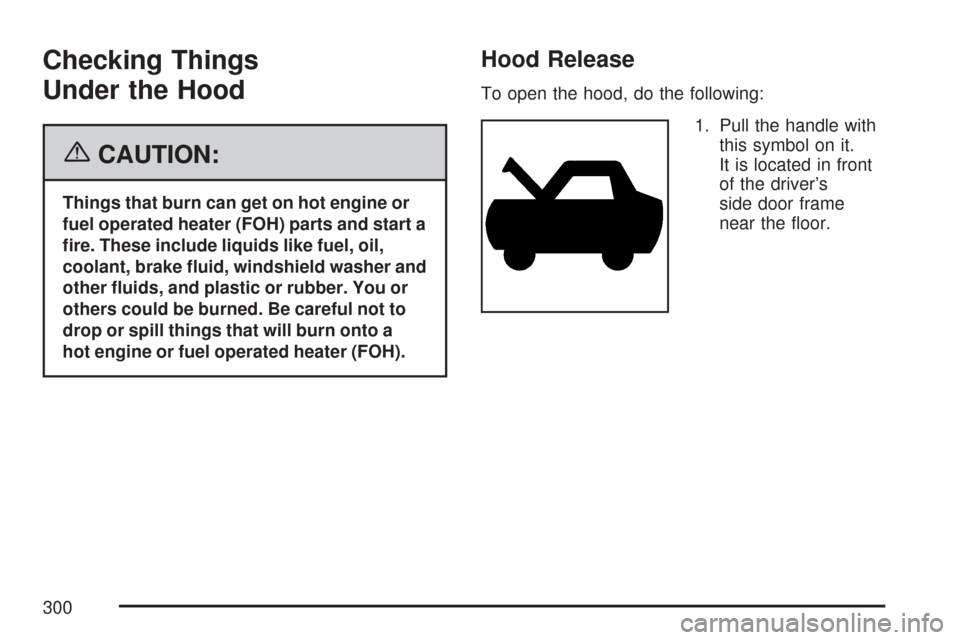
Checking Things
Under the Hood
{CAUTION:
Things that burn can get on hot engine or
fuel operated heater (FOH) parts and start a
�re. These include liquids like fuel, oil,
coolant, brake �uid, windshield washer and
other �uids, and plastic or rubber. You or
others could be burned. Be careful not to
drop or spill things that will burn onto a
hot engine or fuel operated heater (FOH).
Hood Release
To open the hood, do the following:
1. Pull the handle with
this symbol on it.
It is located in front
of the driver’s
side door frame
near the floor.
300
Page 303 of 458
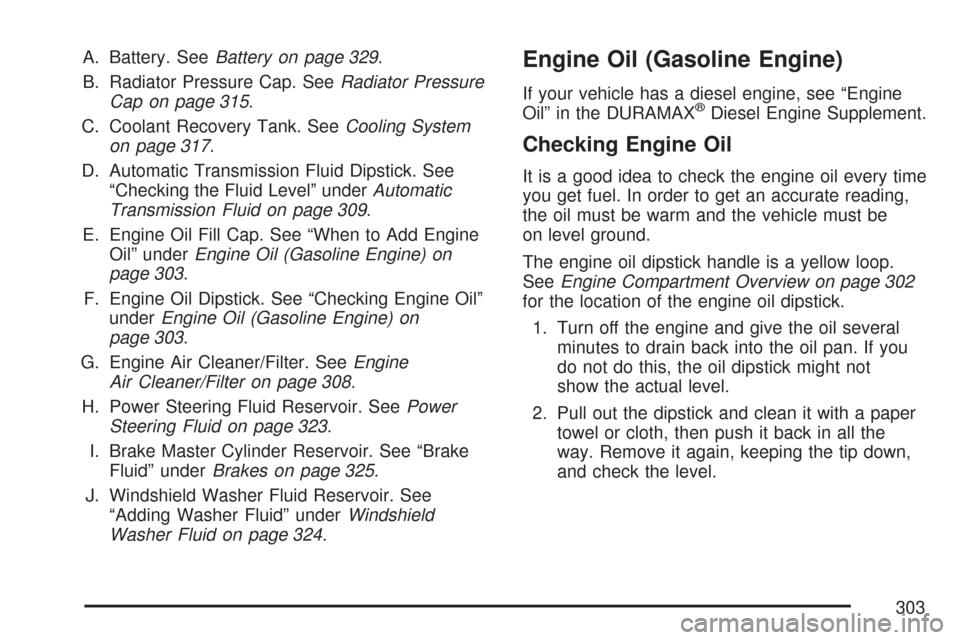
A. Battery. SeeBattery on page 329.
B. Radiator Pressure Cap. SeeRadiator Pressure
Cap on page 315.
C. Coolant Recovery Tank. SeeCooling System
on page 317.
D. Automatic Transmission Fluid Dipstick. See
“Checking the Fluid Level” underAutomatic
Transmission Fluid on page 309.
E. Engine Oil Fill Cap. See “When to Add Engine
Oil” underEngine Oil (Gasoline Engine) on
page 303.
F. Engine Oil Dipstick. See “Checking Engine Oil”
underEngine Oil (Gasoline Engine) on
page 303.
G. Engine Air Cleaner/Filter. SeeEngine
Air Cleaner/Filter on page 308.
H. Power Steering Fluid Reservoir. SeePower
Steering Fluid on page 323.
I. Brake Master Cylinder Reservoir. See “Brake
Fluid” underBrakes on page 325.
J. Windshield Washer Fluid Reservoir. See
“Adding Washer Fluid” underWindshield
Washer Fluid on page 324.Engine Oil (Gasoline Engine)
If your vehicle has a diesel engine, see “Engine
Oil” in the DURAMAX®Diesel Engine Supplement.
Checking Engine Oil
It is a good idea to check the engine oil every time
you get fuel. In order to get an accurate reading,
the oil must be warm and the vehicle must be
on level ground.
The engine oil dipstick handle is a yellow loop.
SeeEngine Compartment Overview on page 302
for the location of the engine oil dipstick.
1. Turn off the engine and give the oil several
minutes to drain back into the oil pan. If you
do not do this, the oil dipstick might not
show the actual level.
2. Pull out the dipstick and clean it with a paper
towel or cloth, then push it back in all the
way. Remove it again, keeping the tip down,
and check the level.
303
Page 306 of 458

If you are in an area of extreme cold, where the
temperature falls below−20°F (−29°C), it is
recommended that you use either an SAE 5W-30
synthetic oil or an SAE 0W-30 oil. Both provide
easier cold starting and better protection for
the engine at extremely low temperatures.
Engine Oil Additives
Do not add anything to the oil. The recommended
oils with the starburst symbol that meet GM
Standard GM6094M are all you need for good
performance and engine protection.
Engine Oil Life System
(Gasoline Engine)
When to Change Engine Oil
Your vehicle has a computer system that lets you
know when to change the engine oil and filter.
This is based on engine revolutions and engine
temperature, and not on mileage. Based on driving
conditions, the mileage at which an oil change
will be indicated can vary considerably. For the oil
life system to work properly, you must reset the
system every time the oil is changed.When the system has calculated that oil life has
been diminished, it will indicate that an oil change is
necessary. A change engine oil light will come on.
SeeChange Engine Oil Light on page 183. Change
the oil as soon as possible within the next 600 miles
(1 000 km). It is possible that, if you are driving
under the best conditions, the oil life system might
not indicate that an oil change is necessary for over
a year. However, the engine oil and filter must be
changed at least once a year and at this time the
system must be reset. Your dealer/retailer has
trained service people who will perform this work
using genuine parts and reset the system. It is also
important to check the oil regularly and keep it at
the proper level.
If the system is ever reset accidentally, you must
change the oil at 3,000 miles (5 000 km) since
your last oil change. Remember to reset the oil life
system whenever the oil is changed.
306
Page 309 of 458
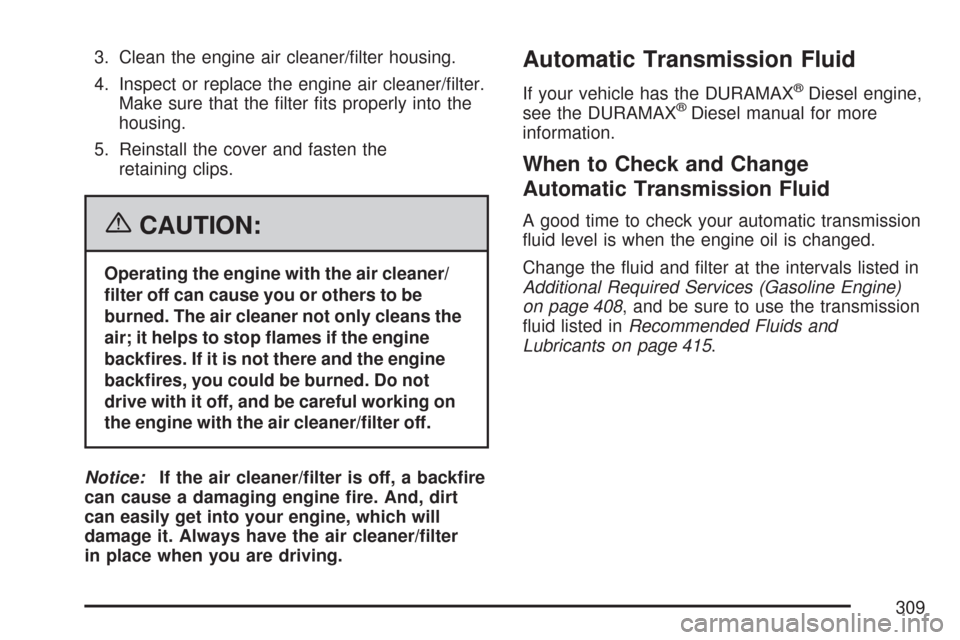
3. Clean the engine air cleaner/filter housing.
4. Inspect or replace the engine air cleaner/filter.
Make sure that the filter fits properly into the
housing.
5. Reinstall the cover and fasten the
retaining clips.
{CAUTION:
Operating the engine with the air cleaner/
�lter off can cause you or others to be
burned. The air cleaner not only cleans the
air; it helps to stop �ames if the engine
back�res. If it is not there and the engine
back�res, you could be burned. Do not
drive with it off, and be careful working on
the engine with the air cleaner/�lter off.
Notice:If the air cleaner/�lter is off, a back�re
can cause a damaging engine �re. And, dirt
can easily get into your engine, which will
damage it. Always have the air cleaner/�lter
in place when you are driving.
Automatic Transmission Fluid
If your vehicle has the DURAMAX®Diesel engine,
see the DURAMAX®Diesel manual for more
information.
When to Check and Change
Automatic Transmission Fluid
A good time to check your automatic transmission
fluid level is when the engine oil is changed.
Change the fluid and filter at the intervals listed in
Additional Required Services (Gasoline Engine)
on page 408, and be sure to use the transmission
fluid listed inRecommended Fluids and
Lubricants on page 415.
309
Page 310 of 458
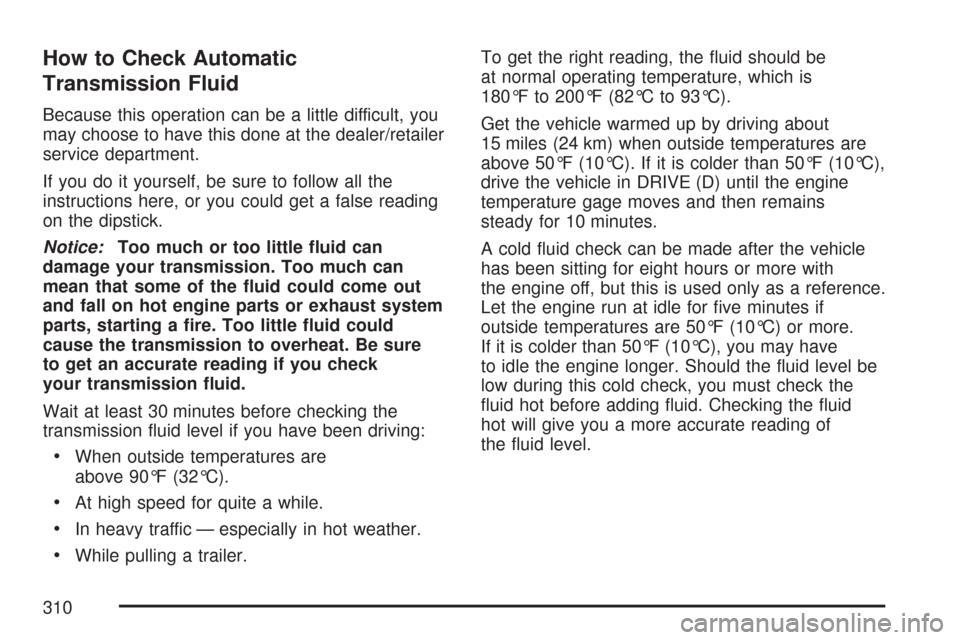
How to Check Automatic
Transmission Fluid
Because this operation can be a little difficult, you
may choose to have this done at the dealer/retailer
service department.
If you do it yourself, be sure to follow all the
instructions here, or you could get a false reading
on the dipstick.
Notice:Too much or too little �uid can
damage your transmission. Too much can
mean that some of the �uid could come out
and fall on hot engine parts or exhaust system
parts, starting a �re. Too little �uid could
cause the transmission to overheat. Be sure
to get an accurate reading if you check
your transmission �uid.
Wait at least 30 minutes before checking the
transmission fluid level if you have been driving:
•When outside temperatures are
above 90°F (32°C).
•At high speed for quite a while.
•In heavy traffic — especially in hot weather.
•While pulling a trailer.To get the right reading, the fluid should be
at normal operating temperature, which is
180°F to 200°F (82°C to 93°C).
Get the vehicle warmed up by driving about
15 miles (24 km) when outside temperatures are
above 50°F (10°C). If it is colder than 50°F (10°C),
drive the vehicle in DRIVE (D) until the engine
temperature gage moves and then remains
steady for 10 minutes.
A cold fluid check can be made after the vehicle
has been sitting for eight hours or more with
the engine off, but this is used only as a reference.
Let the engine run at idle for five minutes if
outside temperatures are 50°F (10°C) or more.
If it is colder than 50°F (10°C), you may have
to idle the engine longer. Should the fluid level be
low during this cold check, you must check the
fluid hot before adding fluid. Checking the fluid
hot will give you a more accurate reading of
the fluid level.
310
Page 311 of 458
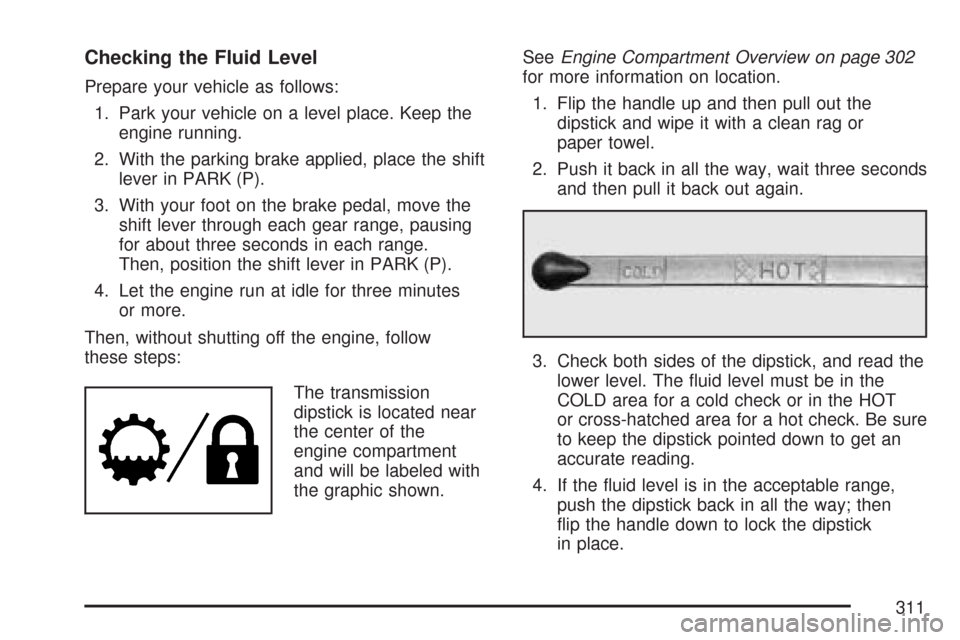
Checking the Fluid Level
Prepare your vehicle as follows:
1. Park your vehicle on a level place. Keep the
engine running.
2. With the parking brake applied, place the shift
lever in PARK (P).
3. With your foot on the brake pedal, move the
shift lever through each gear range, pausing
for about three seconds in each range.
Then, position the shift lever in PARK (P).
4. Let the engine run at idle for three minutes
or more.
Then, without shutting off the engine, follow
these steps:
The transmission
dipstick is located near
the center of the
engine compartment
and will be labeled with
the graphic shown.SeeEngine Compartment Overview on page 302
for more information on location.
1. Flip the handle up and then pull out the
dipstick and wipe it with a clean rag or
paper towel.
2. Push it back in all the way, wait three seconds
and then pull it back out again.
3. Check both sides of the dipstick, and read the
lower level. The fluid level must be in the
COLD area for a cold check or in the HOT
or cross-hatched area for a hot check. Be sure
to keep the dipstick pointed down to get an
accurate reading.
4. If the fluid level is in the acceptable range,
push the dipstick back in all the way; then
flip the handle down to lock the dipstick
in place.
311